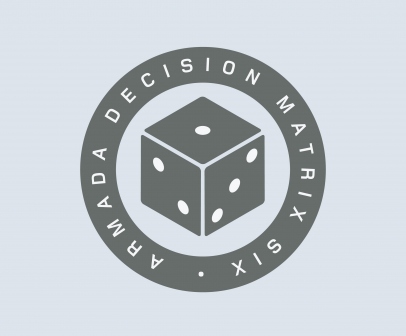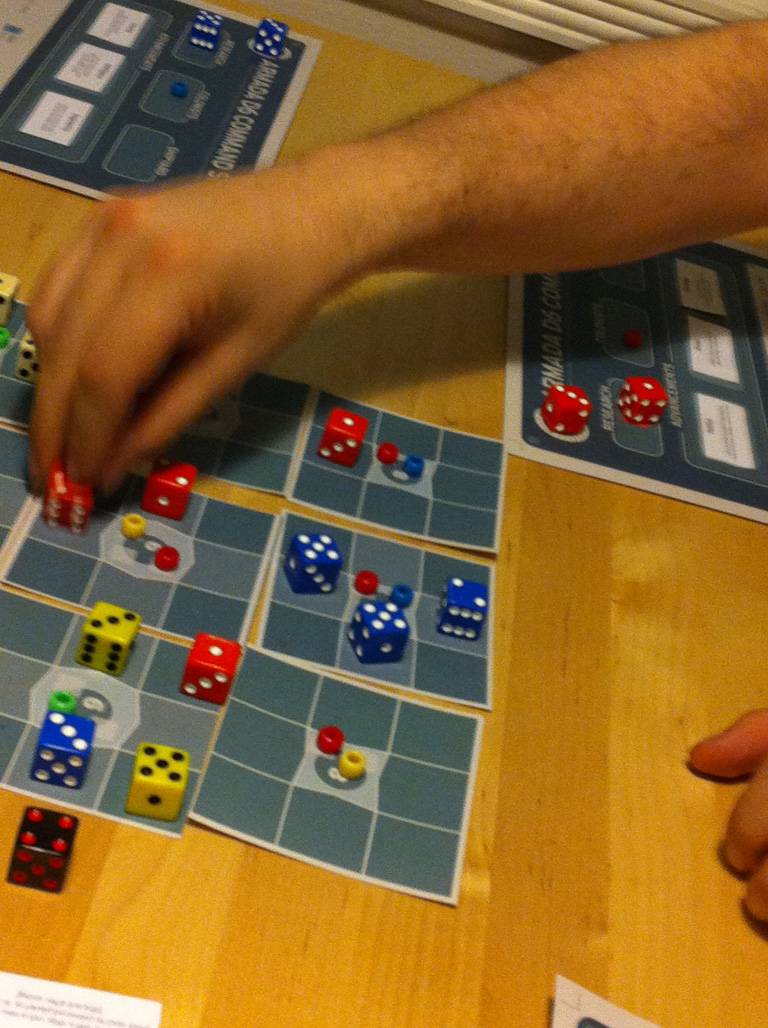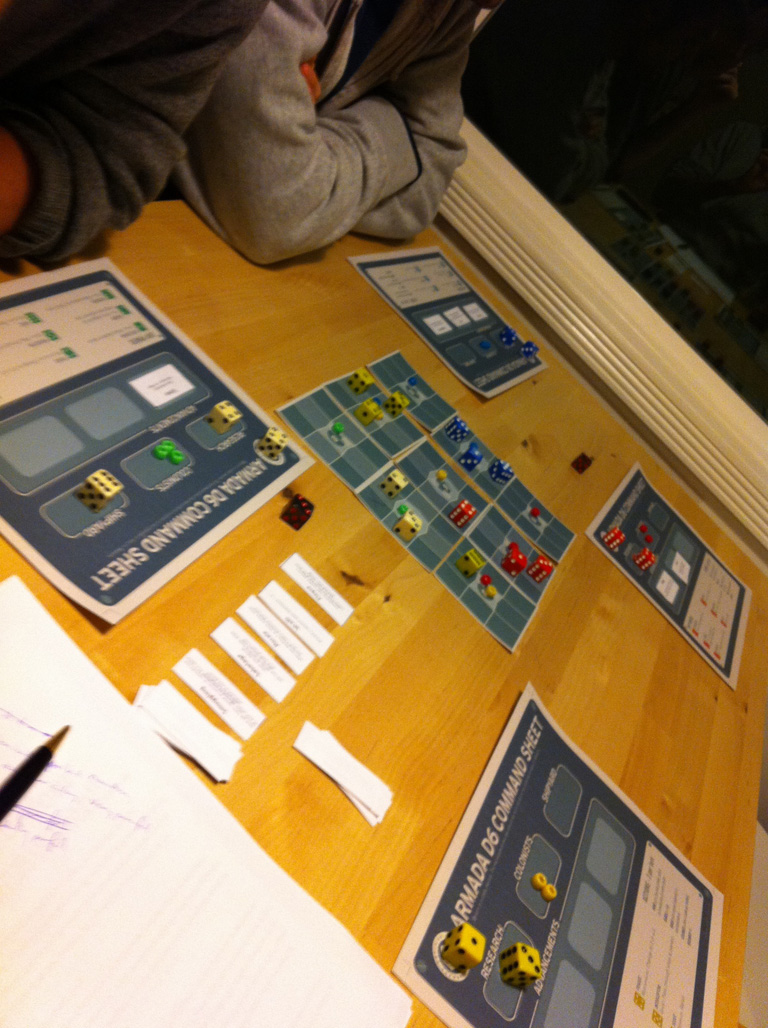elegance and armada d6
Elegance is a word that is used frequently in conversation by game designers, yet there has been very little written on the internet about elegance in game design. Some of that probably stems from the fact that it's hard to define. In fact, a high percentage of the discussion that does exist starts with a dictionary definition for that very reason. It's an easy launching point for talking about something nebulous. Mark Rosewater, the head designer for Magic: the Gathering, has an article on the subject, but even he seemed to steer towards writing rather than game design. (I'm not 100% sure, because for an article about elegance, the formatting was surprisingly tiresome and impenetrable.) He does follow the trend of starting with the definition, though, so who am I to differ:
Elegance is...
- refined grace or dignified propriety
- tasteful richness of design or ornamentation
- dignified, gracefulness or restrained beauty of style
- scientific precision, neatness and simplicity
- something that is elegant
Thanks, Merriam-Webster, for that fifth one. For the purposes of game design, the third definition speaks to me the most, with a touch of the fourth as well. So, dignity, grace, restrained beauty, style, precision, neatness and simplicity. Easy enough, right?
Jesse Schell also touches on elegance in his esteemed book, The Art of Game Design. "We call simple systems that perform robustly in complex situations elegant. Elegance is one of the most desirable qualities in any game, because it means you have a game that is simple to learn and understand, but is full of interesting emergent complexity." He goes on to say, "You can easily rate the elegance of a given game element by counting the number of purposes it has." This seems like a reasonable rule of thumb for approximating elegance, although I think there is slightly more to it than that.
Here are my primary aspects of elegance as pertaining to game design:
- Simple rules that create emergent complexity.
- Single elements used for multiple purposes.
- Conform to player expectations.
Conforming to player expectations can take a variety of flavors, but it includes all sorts of common situations like using white/green/blue/purple rarity colors in your loot system, making higher numbers the more desirable result, or making the shotgun deal high damage at close range but no damage at long range. Why is this a factor in elegance? Because it frees up the minds of your players for understanding the other aspects of your system. The more you can make them feel at home, the more brainpower they'll have for appreciating what makes your game unique. (This is actually one of the toughest aspects of making a sci-fi RPG; you can't rely on the common fantasy elements like zombies, goblins, swords and bows that everyone understands.)
Victory points, a common mechanic in German board games, aren't particularly elegant because they are divorced from the theme and they serve only a singular purpose. For example, as mentioned in my post about 7 Wonders, the most elegant potential victory condition in that game would be completing the construction of your wonder, as that's what players will expect based on the name and theme. However, that would mean that the wonders would all need to be perfectly balanced against one another, and would heavily warp the mechanics towards either hurrying construction of your own wonder or somehow delaying construction of another player's wonder. Through the use of victory points, Antoine Bauza was both able to create multiple viable paths to victory and also give himself built-in tuning knobs for adjusting the effectiveness of each one.
During GDC I had the pleasure of playtesting a prototype of a board game, Armada d6, from Eric Zimmerman and John Sharp. The game just oozes elegance out of every pore, from the components to the mechanics, and was the catalyst to me writing this post.
So what is Armada d6?
It's a battle for space colonization where the ships are represented by dice. The basic game can be completed in as little as 10-15 minutes (or longer, depending on the level of aggression), and there's an advanced game that adds more depth. There are six different types of ships, each denoted by a different face of the die, with the lower numbers representing the hulks of the battlefield, slow but strong, and the higher numbers representing their fast and sleek opposites. Each ship can move a number of squares equal to its number, and combat is resolved by each player rolling a separate die and adding their ship number to it, with the lowest total winning. Colonization is achieved by surrounding a planet with multiple ships whose values sum to exactly the colonization number of that planet (always a number from 7-9, displayed directly on the planet).
So in total, each of the player's core dice is used for:
- Marking the location of a ship.
- Denoting what kind of ship it is and by extension the ability of that ship.
- Defining the exact speed of that ship.
- Defining the colonization potential of the ship.
- Defining the inverse combat potential of the ship.
You could easily imagine a version of this game created by less seasoned designers where the six ships each have their own individual stats contained in a chart off to the side. Maybe the 6 ship (scout) turns out to be a little too good with a colonization potential of 6, so with the chart you could adjust its colonization down to 5, and maybe give it a point of speed to compensate. In a different situation, opening up that flexibility would be a great move. But here the payoff of having the ships conform to their directly visible numbers is so strong that it's clearly the right decision. And since everyone has access to the same ship options and there is a built-in way to reroll your ships, small imbalances are hardly even a problem. With the base components supporting five different purposes, using Jesse Schell's definition of elegance, Armada d6 is already off to the races.
As for simple rules that create emergent complexity, the game excels at both sides of the equation. It provides you with a clear goal (maneuver your ships with a certain summed value next to a planet with that number) and leaves it up to you to find the solution. Everything except for the special abilities is right there on the game board; since the speed and colonization potential are both equivalent to the visible number on the die, planning high level strategy is a breeze. The more accomplished players can start to explore the possibility space that the special abilities open up, with options like transporting other ships, free ship rerolls, or retrofitting to a ship that's one number higher or lower. Every turn is a puzzle with variable difficulty settings -- the easy level is focusing just on your ship numbers and moving them to a nearby planet, the medium level is starting to consider the ship abilities and how they affect your plans, and the advanced level is looking at your opponents and what they're trying to set up, and seeing if you can disrupt it with a few well-placed attacks.
For conforming to player expectations, there is only one flaw: that combat both rewards lower ship numbers and asks you to roll low for success. I always strive to avoid this in my designs. That said, there are successful games that utilize a similar system (Axis & Allies) and the payoff of having the speed/combat potential tradeoff inherent in the ship's value is more than worth it here.
One potential upgrade in terms of elegance would be to eliminate the need for outside dice during combat by rolling the ship itself. Of course, there are three obvious problems with this: it requires you to remember where your ship was, it requires you to remember what type of ship it was, and it makes it harder to do the combat math since your ship's combat value is no longer visible when you're figuring it out. Three strikes is enough to convince me that Eric was correct in leaving it out, but it's a worthwhile thought experiment to consider.
In the advanced game there's a mechanic where you can unlock advancements, and each time that happens you could either research one out of three technologies randomly (chosen from a personal pool of five at the beginning), or add one to your maximum number of ships (plus deploy a ship immediately), or add one to your number of actions starting next turn. The problem I discovered during the playtest was that for the most part it was just better to take the extra action every time. Taking extra ships didn't help because you needed actions to take advantage of having more ships, and the technologies were of varying usefulness so a random one was too risky. This is a common problem with action-based games, such as Agricola, although it's handled rather elegantly and thematically in that game. Adding a member to your family requires constructing an additional room in your house, taking a family growth action that's restricted in availability, and has an ongoing upkeep cost of additional food, so the extra action ends up being reasonably balanced (although still quite strong).
But back to Armada d6. One of the proposed solutions was that you couldn't ever have more actions than you had ships (you started with three of each). We dismissed this quickly, but I want to highlight why, as it can be very tempting to add rules like this when designing a game:
- Rules like this are usually applied as a band-aid to mitigate a more systemic problem with the game. This is pretty much the opposite of elegance and leads to them feeling tacked on.
- These rules tend to be hard to remember because they often have no association with the theme or flavor of the game.
- They often restrict player choice. In this case the player will generally only take a ship upgrade with the plan of taking an action upgrade next, which puts them on a specific pattern and makes what should be a three-pronged choice into a binary choice instead. Ideally the three upgrade paths should be balanced more organically.
We also discussed increasing the power of the other upgrades to make the choice more interesting, as in letting you choose your technology or giving you two extra ships if you choose that upgrade. Eventually, though, another group of players (Jason Rohrer and Christina Norman I think) suggested another idea, which was to roll both the extra actions and the extra ships into the technology system, and rather then forcing the player to make a somewhat awkward choice about personal techs at the beginning, instead just place a global random selection of techs off to the side of the board. Players can choose the one they want when they earn an upgrade and then the chosen tech is replaced with another random one. That way players are a lot more invested in the tech choices of their opponents, they can try to race for desirable techs, and they can't just continually choose to take extra actions since they're limited by the current selection.
In conclusion: elegance is a truly desirable quality in a game, although it shouldn't be pursued to the exclusion of all else. Armada d6 is one of the most elegant games I've ever played and is clearly the result of a series of strong design choices. I know Eric and John are currently looking for a publisher and I wish them the best of luck, because I look forward to playing more!
(Photos by Richard Lemarchand and John Sharp.)




March 28th, 2011 - 08:14
Awesome article. I remember eying you playtesters with envy at the board game night! This is a great overview of elegance in games. I found myself agreeing with every individual point you made, as I’d come to those conclusions before, but it’s great to have everything presented in one place in a coherent fashion.
Also: I love to that the design solution that Jason contributed to essentially cribs from the upgrade mechanic in his latest game, Inside a Star-Filled Sky.
March 29th, 2011 - 03:41
Thanks Darius! Judging from the photos I think the new version of Armada d6 has already implemented that tech idea, which doesn’t surprise me as it seemed to be a pretty clear upgrade. In the version I played people were frequently surprised by the techs their opponents had, but this way they all pass through the public eye first. It was a great suggestion.
I really need to play Inside a Star-Filled Sky. Not sure why I haven’t yet.
May 24th, 2011 - 10:18
Loved this article. More playtests / game analyses please.
July 1st, 2011 - 11:50
Loved this article, it’s probably the best description (and well-related example) of elegance in game design that I’ve read. Your final point – proposing a rule, but then pointing out its inelegance as a “band-aid” – is something that I think will particularly enlighten a lot of folks; I’ve played too many games that simply layer many very specific “you can’t X, you can’t Y” rules in as obvious, inelegant, and hard-to-remember band-aids…
I like the emphasis of what I would call “the principle of least surprise” – a universally important principle to all types of design – as an element of elegance. It’s funny how you can get away with very complex rule systems (example: the rules of physics) so long as they’re ones that people are intuitively familiar-with and understand.
July 11th, 2011 - 20:08
Thanks Shay!
I like your name for the principle. Thinking about it more, it poses an interesting dilemma in some ways; the more we rely on the audience having picked up specific knowledge from previous games of the genre, the more complicated (and deep?) games we can make. But too much of that and the game could become inaccessible to anyone coming in from a different entry point. Certainly something common to the human experience like physics or “resting makes you less tired” you get pretty much for free though.
I haven’t had a chance to check out Connectrode yet but I’m looking forward to it. I love that you got David Pencil to do the music, I’ve been a fan of his since he started composing for PATV.
September 22nd, 2011 - 04:17
“Elegance is a truly desirable quality in a game, although it shouldn’t be pursued to the exclusion of all else.” – I agree with you point! The quality of the game is what gamers are looking for. I’m sure Armada d6 will soon gain so much popularity in the gamers world… Good luck guys!